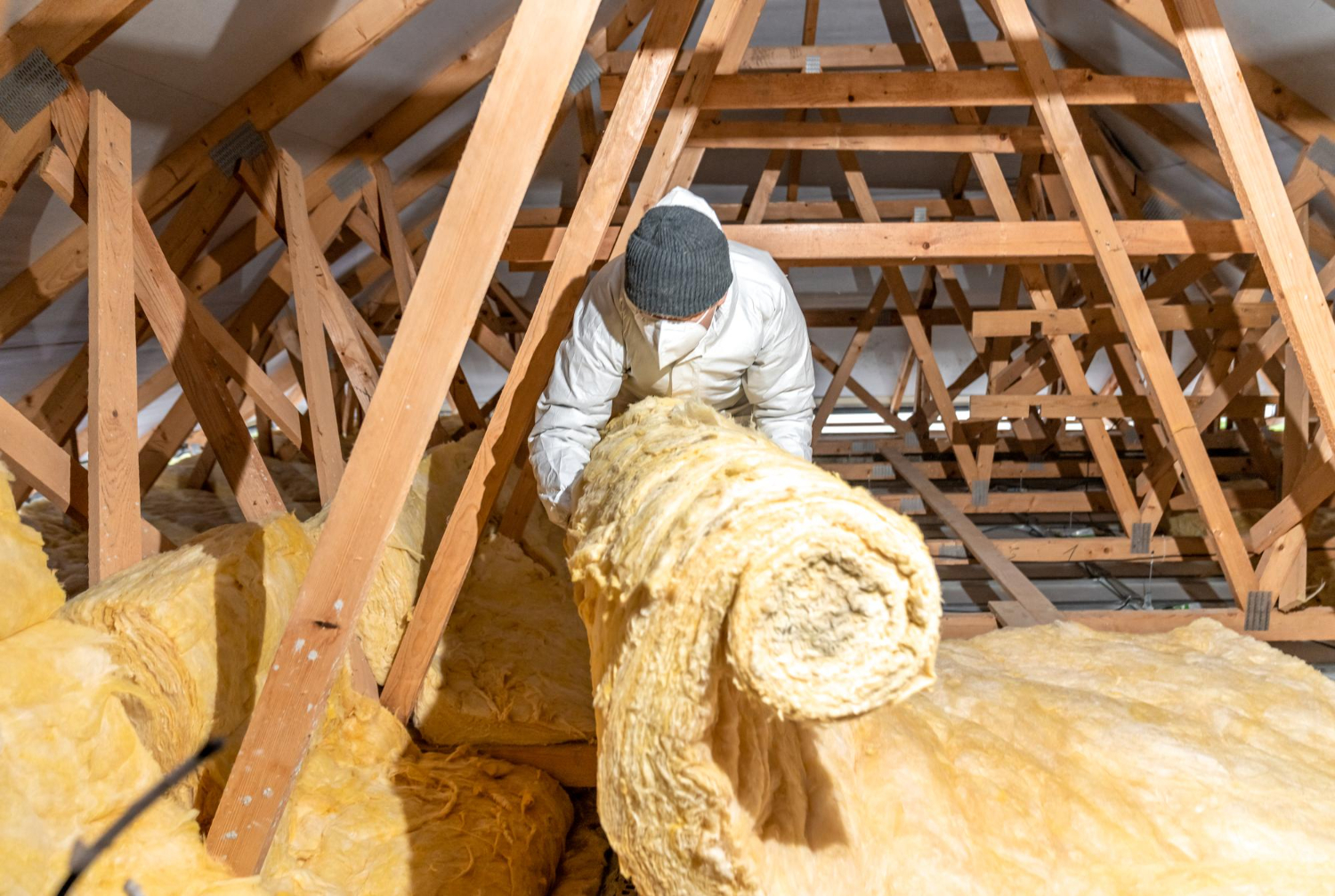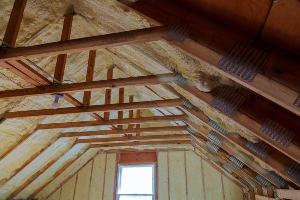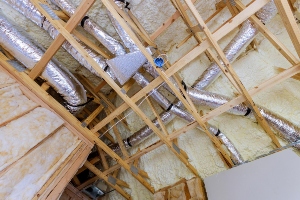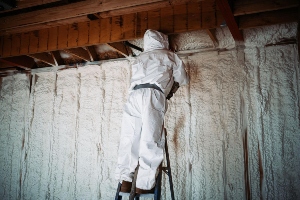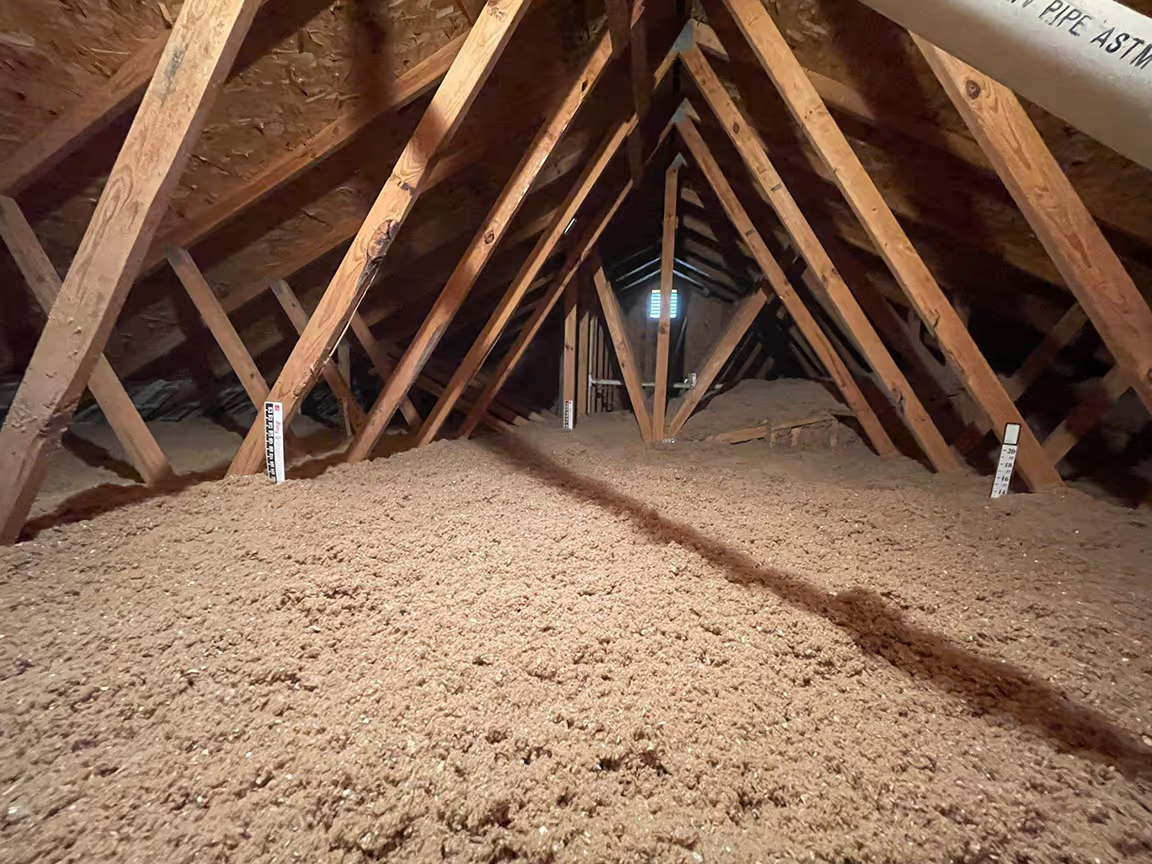Modern sustainable insulation options can match or beat traditional materials in thermal performance while protecting both your family and the planet.
Many homeowners think choosing eco-friendly insulation means giving up performance and comfort. This common worry keeps people using traditional materials that harm the environment and their health.
We can now choose from materials like recycled denim, sheep wool, and cellulose that offer excellent R-values without toxic chemicals. These options come from renewable sources and often cost less over time through energy savings.
Our guide will help you understand what makes insulation truly sustainable and compare the best eco-friendly types for different parts of your home.
We'll also explore how these materials support healthier living and our approach to creating more sustainable homes without compromising on comfort or performance.
Through the topics below, you’ll learn how eco-friendly materials compare, where they work best, and how they support healthier living:
- What makes insulation truly sustainable?
- Comparing the most eco-friendly insulation types
- Eco-friendly insulation for every part of your home
- How sustainable insulation supports healthier living
- The Terra approach to eco-friendly home insulation
Let's dive in!
What makes insulation truly sustainable?
Sustainable insulation goes beyond just energy savings to include how materials are made, what they contain, and their impact on indoor air quality. The most eco-friendly options use recycled content, emit minimal chemicals, and break down naturally at the end of their life cycle.
Key traits of environmentally friendly insulation
Truly sustainable insulation materials share several important characteristics that set them apart from conventional options. These traits help us identify which products will best support our environmental goals.
Natural or recycled raw materials form the foundation of eco-friendly insulation. Plant-based options like hemp, cotton, and wood fiber come from renewable sources. Recycled materials like denim or newspaper give new life to waste products.
Low manufacturing impact means the production process uses less energy and creates fewer emissions. Many sustainable insulation types require minimal processing compared to synthetic alternatives.
Non-toxic composition protects both installers and occupants. These materials don't release harmful chemicals during installation or over time. They're safe to handle without protective gear.
Renewable or recyclable nature ensures the material won't burden landfills forever. Some options can be composted or recycled when buildings are renovated or demolished.
Understanding recycled content, VOCs, and biodegradability
Recycled content refers to how much of the insulation comes from previously used materials. Products with high recycled content reduce waste and demand for new raw materials. Cotton insulation often contains 85% recycled denim fibers.
VOCs (Volatile Organic Compounds) are chemicals that evaporate at room temperature and can harm indoor air quality. Sustainable insulation materials emit very low or zero VOCs. This creates healthier living spaces and reduces respiratory irritation.
Natural materials like wool and cellulose typically have minimal VOC emissions. Synthetic options may contain formaldehyde or other harmful compounds.
Biodegradability means materials break down naturally without leaving toxic residues. Plant-based insulations decompose when exposed to moisture and bacteria. This reduces long-term environmental impact compared to synthetic materials that persist in landfills.
Some biodegradable options include:
- Hemp fiber insulation
- Cork insulation
- Straw bale insulation
- Wood fiber batts
Certifications that matter when going green
Third-party certifications help us verify sustainability claims and make informed choices. These programs test materials for environmental impact and performance standards.
GREENGUARD certification confirms low chemical emissions for better indoor air quality. Products must meet strict VOC limits during testing. This certification particularly matters for sensitive individuals.
Energy Star qualification indicates the insulation meets energy efficiency requirements. These products help reduce heating and cooling costs while supporting environmental goals.
Forest Stewardship Council (FSC) certification applies to wood-based insulation materials. It ensures responsible forest management and sustainable harvesting practices.
Cradle to Cradle Certified evaluates the entire product lifecycle. This comprehensive program examines material health, renewable energy use, and recyclability.
We should look for multiple certifications rather than relying on a single standard. This approach provides better assurance of true sustainability across different environmental factors.
Comparing the most eco-friendly insulation types
Natural fiber options like cellulose and cotton offer strong performance with minimal environmental impact. Spray foam presents a complex trade-off between high efficiency and sustainability concerns.
According to the EPA, insulation labeled as greener must offer greater R-value, reduced or eliminated toxins (like formaldehyde and VOCs), high recycled content, low embodied energy, sustainably sourced, and end-of-life recyclability.
Cellulose, cotton, and other natural fiber options
Typical green insulation products such as fiberglass and cellulose contain significant recycled content, are safe, cost-effective, and backed by ENERGY STAR guidance.
Cellulose insulation stands out as one of the most sustainable choices available. Made from recycled newspaper and cardboard, it diverts waste from landfills while providing excellent thermal performance.
Cotton insulation, often made from recycled denim, offers another eco-friendly alternative. This natural fiber material contains no harmful chemicals and can be safely handled without protective equipment.
Hemp insulation provides impressive moisture resistance and pest control properties. As a rapidly renewable crop, hemp requires minimal water and pesticides during growth.
Sheep's wool insulation naturally regulates humidity and resists fire without chemical treatments. This renewable material biodegrades completely at the end of its useful life.
Key Benefits of Natural Fiber Insulation:
- Biodegradable and renewable
- Low manufacturing energy requirements
- Safe installation without toxic fumes
- Excellent sound absorption
These materials typically cost 10-30% more than fiberglass but offer superior indoor air quality benefits.
Is spray foam ever sustainable? Pros and cons
Spray foam insulation presents a sustainability dilemma. While it delivers exceptional R-values and air sealing, its environmental impact raises concerns.
Pros of Spray Foam:
- Highest R-value per inch (R-6 to R-7)
- Eliminates air leaks effectively
- Reduces overall energy consumption
- Long-lasting performance
Cons of Spray Foam:
- Made from petroleum-based chemicals
- High embodied energy in production
- Difficult to remove and recycle
- Potential off-gassing concerns
Some manufacturers now offer bio-based spray foam made from plant oils. These newer formulations reduce petroleum dependence by 20-30% while maintaining performance standards.
We recommend spray foam primarily for hard-to-insulate areas where its superior sealing properties justify the environmental trade-offs.
R-Value vs. environmental impact: Finding balance
R-value measures thermal resistance, but higher numbers don't always mean better environmental choices. We must consider the full lifecycle impact of insulation materials.
Insulation Performance Comparison:
Material
R-Value per Inch
Environmental Score
Cellulose
3.6-3.8
Excellent
Cotton
3.4-3.8
Very Good
Hemp
3.5-3.8
Excellent
Spray Foam
6.0-7.0
Fair
Natural fiber options achieve adequate R-values while offering superior sustainability. Their lower embodied energy and renewable sources often outweigh slightly reduced thermal performance.
Climate zone affects this balance significantly. Colder regions may benefit from spray foam's higher R-value despite environmental concerns.
We recommend calculating total energy savings over 20+ years. Natural fiber insulation often provides better long-term environmental benefits through reduced manufacturing impact and end-of-life disposal advantages.
Eco-friendly insulation for every part of your home
Different areas of your home need specific types of eco-friendly insulation to work best. The right green materials can handle moisture, temperature changes, and structural needs while keeping your home comfortable.
Best options for attic insulation that's low-impact
Cellulose insulation works great in attics because it's made from recycled paper. It fills gaps well and has an R-value of 3.6 per inch.
Sheep's wool is another top choice for attic spaces. It can absorb moisture without losing its insulating power. This natural material regulates humidity and resists fire.
Cork insulation boards work well in attics where you need rigid panels. Cork comes from tree bark that grows back, making it renewable.
We recommend blown-in cellulose for most attic projects. It covers hard-to-reach spots and costs less than many other green options.
Key benefits for attic use:
- Handles temperature swings
- Fills irregular spaces
- Easy to install over existing insulation
- Won't settle as much as some materials
Green materials for walls, basements, and crawlspaces
Cotton insulation made from recycled denim works well in wall cavities. It's safe to handle and has similar R-values to fiberglass.
For basements and crawlspaces, we need materials that handle moisture. Hemp insulation resists mold and pests naturally. It also regulates humidity levels.
Wood fiber boards work great for basement walls. They're made from wood waste and can handle some moisture without damage.
Material
Best Use
R-Value per inch
Moisture Resistance
Cotton batts
Interior walls
3.4
Fair
Hemp insulation
Basements
3.5
Good
Wood fiber
Crawlspaces
4.0
Excellent
Recycled polyester batting offers good performance in walls. It's made from plastic bottles and won't irritate skin during installation.
When thermal barriers align with sustainability goals
Thermal barriers help stop heat transfer and work with green insulation to boost performance. Reflective barriers made from recycled aluminum reduce radiant heat.
Natural latex foam creates an effective thermal barrier while being biodegradable. It seals air leaks better than many fiber-based materials.
We can combine different eco-friendly materials for better results. Cork boards with cellulose fill create strong thermal barriers in walls.
Mycelium insulation is new but promising. It's grown from mushroom roots and creates its own thermal barrier as it cures.
The key is matching thermal barrier properties with your climate. Hot climates need radiant barriers while cold areas need materials that stop conductive heat loss.
Effective combinations:
- Cork + cellulose for walls
- Reflective barrier + sheep's wool for attics
- Hemp + natural latex for basements
How sustainable insulation supports healthier living
Sustainable insulation materials create safer indoor environments by removing harmful chemicals from our homes. These natural options also improve air quality and help control moisture better than traditional products.
Avoiding toxins in conventional insulation
Traditional fiberglass insulation contains formaldehyde, a chemical that releases harmful gases into our homes. These gases can cause headaches, throat irritation, and breathing problems over time.
Many conventional insulation products also use chemical binders and flame retardants. These substances can off-gas for years after installation.
Natural insulation materials like wool and cotton are formaldehyde-free. They don't contain synthetic chemicals that can harm our health. We can handle these materials safely without gloves or masks.
Cellulose insulation made from recycled paper uses safer fire retardants. These are typically boron-based compounds that don't release toxic fumes like synthetic alternatives.
When we choose natural materials, we eliminate the risk of chemical exposure. This is especially important for children and people with asthma or allergies.
Benefits for indoor air quality and moisture control
Natural insulation materials help our homes breathe better. Wool and cotton fibers naturally absorb and release moisture without losing their insulating power.
This moisture control prevents mold and mildew growth. Synthetic materials can trap moisture, creating perfect conditions for harmful bacteria.
Sheep's wool insulation can absorb up to 30% of its weight in moisture. It releases this moisture slowly when humidity levels drop. This natural process helps maintain comfortable indoor conditions.
Natural materials don't release particles into the air like fiberglass can. Fiberglass particles can irritate our lungs and skin when they become airborne.
Cotton and wool insulation also help filter indoor air. These materials can trap dust and allergens naturally.
The long-term value of choosing natural materials
Natural insulation materials last longer than many synthetic options. Wool and cotton maintain their structure for decades without breaking down.
These materials don't settle or compress as much over time. This means our homes stay well-insulated for years without needing replacement.
Natural materials are also easier to remove and replace when needed. We don't need special equipment or safety gear to handle them during renovations.
The durability of natural insulation means fewer replacements over our home's lifetime. This reduces waste and saves money in the long run.
Natural materials also age better than synthetic options. They don't become brittle or release more chemicals as they get older.
The Terra approach to eco-friendly home insulation
We combine sustainability with proven performance to deliver insulation solutions that protect both your home and the environment. Our process focuses on selecting materials that meet strict environmental standards while maintaining superior thermal efficiency.
Our commitment to sustainability and performance
We believe eco-friendly insulation should never compromise on effectiveness. Our team selects materials based on two key factors: environmental impact and thermal performance ratings.
Our sustainability criteria include:
- Recycled content percentage
- Manufacturing energy use
- Chemical emissions during production
- End-of-life recyclability
We test each material's R-value to ensure it meets or exceeds traditional insulation standards. This dual approach means you get better energy efficiency without harming the environment.
Our preferred materials include cellulose made from recycled paper and sheep's wool insulation. Both options provide excellent thermal resistance while using renewable or recycled resources.
We also evaluate air sealing properties. Many eco-friendly options naturally resist air leaks better than synthetic materials.
How we help homeowners choose greener materials
We start every project with a detailed assessment of your home's specific needs. This includes measuring existing insulation, identifying air leaks, and calculating the best R-values for your climate zone.
Our selection process covers:
- Budget considerations for sustainable options
- Local climate requirements
- Existing home structure compatibility
- Health and safety factors
We explain the benefits of each material in simple terms. For example, we show how cork insulation naturally resists moisture and pests without chemical treatments.
Our team provides cost comparisons between traditional and eco-friendly options. We include long-term energy savings to show the true value of sustainable choices.
We also help homeowners access tax credits and rebates for energy-efficient upgrades. Many states offer incentives for choosing greener materials.
Past projects that blend eco-responsibility with comfort
We recently completed a Victorian home renovation using recycled denim insulation in the walls and cellulose in the attic. The homeowners reduced their heating costs by 30% while using materials made from post-consumer waste.
Another project involved installing sheep's wool insulation in a modern townhouse. This natural material regulated humidity levels and eliminated the need for vapor barriers.
Project results typically include:
- 25-40% reduction in energy bills
- Improved indoor air quality
- Better temperature consistency
- Reduced environmental impact
We documented a commercial building project where we used cork board insulation. The material provided excellent soundproofing while maintaining stable indoor temperatures year-round.
One family chose recycled glass insulation for their basement renovation. The material performed better than fiberglass while containing 85% recycled content.
Our clients consistently report improved comfort levels and lower utility bills after switching to eco-friendly insulation materials.
Conclusion
We've explored many eco-friendly insulation options that match traditional materials in performance. These sustainable choices help reduce environmental impact while keeping homes comfortable.
Each material offers unique benefits. Some excel at moisture control. Others provide superior fire resistance or sound dampening.
Performance remains strong across all eco-friendly options. Many outperform fiberglass in key areas like air sealing and thermal bridging prevention.
Cost considerations vary by material and region. Installation methods range from DIY-friendly batts to professional spray applications.
We recommend getting quotes for multiple materials. Compare R-values, installation costs, and long-term energy savings.
Sustainable insulation technology continues improving. New products enter the market regularly with better performance and lower environmental impact.
Making the switch to eco-friendly insulation supports both your home's efficiency and environmental goals. The performance gap between traditional and sustainable options has largely disappeared.
Your local building codes and climate will influence the best choice. Consult with insulation professionals familiar with green building materials in your area.
Get expert guidance on eco-friendly insulation, contact our team today for sustainable options that fit your home and climate.

